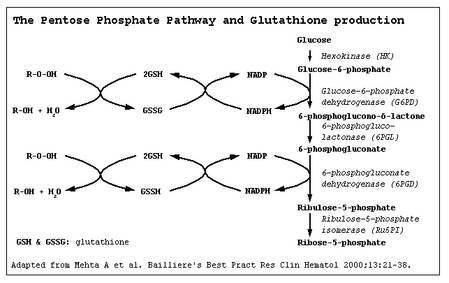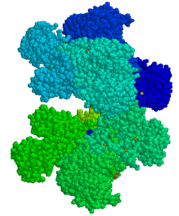Hereditary non-spherocytic hemolytic anemia
Glucose-6-phosphate dehydrogenase (G6PD) deficiency is an X-linked recessive hereditary disease featuring nonimmune hemolytic anemia in response to a number of causes. Its classic association to consumption of broad beans has led to the commonly used term favism, derived from the Italian name of the broad bean (fava). more...
Signs and symptoms
Patients are almost exclusively male, due to the X-linked pattern of inheritance, but female carriers can have a mild form of G6PD. G6PD manifests itself in a number of ways:
- Prolonged neonatal icterus
- Hemolytic crises in response to:
- Certain drugs (see below)
- Certain foods, most notably broad beans
- Illness (severe infections)
- Very severe crises can cause acute renal failure
Drugs that have been linked to G6PD:
- Primaquine (an antimalarial)
- Sulphonamide antibiotics
- Sulphones (e.g. dapsone, used against leprosy)
- Other sulphur-containing drugs: glibenclamide (an anti-diabetic drug)
- Nitrofurantoin (an antibiotic often used for urinary tract infections)
- Several others
Diagnosis
The diagnosis is generally suspected when patients from certain ethnic groups (see below) develop anemia, jaundice and symptoms of hemolysis after challenge to any of the above causes, especially when there is a positive family history.
Generally, tests will include:
- Full blood count and reticulocyte count; in active G6PD, "Heinz bodies" (aggregates of protein) can be seen in red blood cells on a blood film;
- Liver enzymes (to exclude other causes of jaundice);
- Haptoglobin (decreased in hemolysis);
- A "direct antiglobulin test" (Coombs' test) - this should be negative, as hemolysis in G6PD is not immune-mediated;
- TSH measurement.
When there are sufficient grounds to suspect G6PD, a direct test for G6PD is the "Beutler fluorescent spot test", which has largely replaced an older test (the Motulsky dye-decolouration test). Other possibilities are direct DNA testing and/or sequencing of the G6PD gene.
The Beutler fluorescent spot test is a rapid and inexpensive test that visually identifies NADPH produced by G6PD under ultraviolet light. When the blood spot does not fluoresce, the test is positive; it can be false-positive in patients who are actively hemolysing. It can therefore only be done several weeks after a hemolytic episode.
Read more at Wikipedia.org



